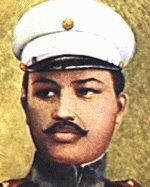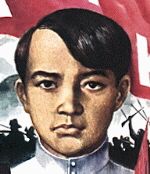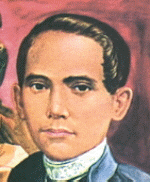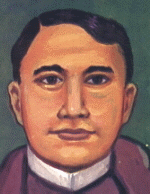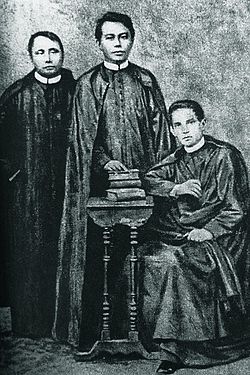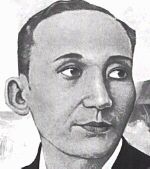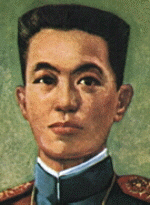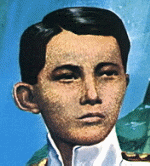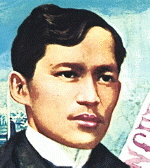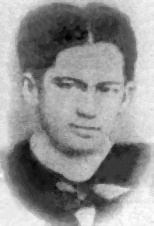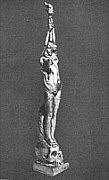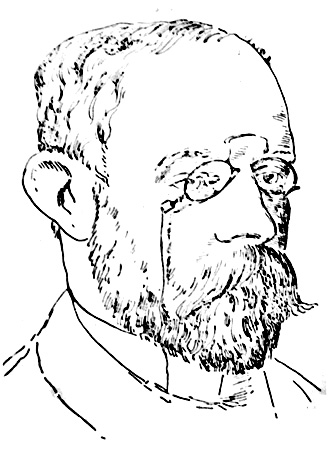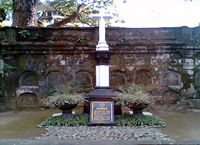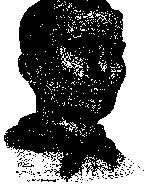 Andres Bonifacio
Andres Bonifacio
(1863-1897)
He founded the secret society, Katipunan, on July 7, 1892, to fight Spain. He was also president of the Tagalog republic from August 24, 1896 to May 10, 1897. Born in Tondo, Manila, on November 30, 1863. He grew up in the slums and never knew the benefits of a prosperous life. He married Gregoria de Jesus in 1892. He was killed on May 10, 1897, near Mount Buntis, Maragondon, Cavite.
Andrés Bonifacio
From Wikipedia, the free encyclopedia
Andrés Bonifacio y de Castro (
November 30,
1863 –
May 10,
1897) was a
Filipino nationalist and
revolutionary. He was a founder and leader of the
Katipunan movement which sought the independence of the
Philippines from
Spanish colonial rule and started the
Philippine Revolution.
[1][2] He is considered a
de facto national hero of the Philippines.
[3] Bonifacio is also considered by some Filipino historians to be the first
president of the Philippines, but he is not officially recognized as such.
Early Life
Bonifacio was born to Santiago Bonifacio and Catalina de Castro
[6] in
Tondo,
Manila and was the eldest of six children.
[7] His father was a tailor who served as a
teniente mayor (municipal official) of Tondo while his mother (a
mestiza of Spanish descent) worked in a cigarette factory.
[8] He was orphaned in his late teens – his mother died of tuberculosis in 1881 and his father followed a year after.
[9] Bonifacio was forced to drop out of school and work to support his family.
[10] He worked as a
mandatorio (clerk/messenger) for the English trading firm Fleming and Company, where he rose to become a
corredor (agent) of tar and other goods. He later transferred to Fressell and Company, a German trading firm, where he worked as a
bodeguero (
warehouseman/agent). He also set up a family business of selling canes and paper fans.
[11][10][8] Bonifacio was married twice. His first wife was a certain Monica who died of leprosy. His second wife was
Gregoria de Jesus of Caloocan, with whom he had one son who died in infancy.
[12][11][10]
Despite not finishing formal education, Bonifacio was self-educated. He read books about the
French Revolution, biographies of the
Presidents of the United States, the Philippine penal and civil codes, and novels such as
Victor Hugo‘s
Les Misérables,
Eugène Sue‘s
Le Juif errant and
José Rizal‘s
Noli Me Tangere and
El Filibusterismo.
[10][8]
Bonifacio was a
Freemason and a member of the
Gran Oriente Español (Spanish Grand Lodge). In 1892 he joined Rizal’s
La Liga Filipina (The Philippine League), an organization which called for political reforms in the Spanish government of the Philippines. However,
La Liga Filipina disbanded after one meeting as Rizal was arrested and deported to the town of
Dapitan in
Mindanao.
[13] Bonifacio,
Apolinario Mabini and others revived
La Liga Filipina in Rizal’s absence. Bonifacio was active at organizing local chapters in Manila.
[13] La Liga Filipina contributed moral and financial support to
Filipino reformists in Spain.
[14]
[edit] Katipunan
On July 7, 1892, the day after Rizal’s deportation was announced, Bonifacio and others founded the
Katipunan, or in full,
Kataastaasan(g) Kagalanggalang na[15] Katipunan ng mga Anak ng Bayan (“Highest and Most Respected Society of the Sons
[16] of the Country
[17]“).
[18] The
secret society sought independence from Spain through armed revolt.
[19][14] It was influenced by Freemasonry through its rituals and organization, and several members aside from Bonifacio were also Freemasons.
[13] Within the society Bonifacio used the pseudonym
Maypagasa (“Hopeful”).
[20]
For a time, Bonifacio worked with both the
Katipunan and
La Liga Filipina. But
La Liga Filipina eventually split because less affluent members like Bonifacio lost hope for peaceful reforms, and stopped their monetary aid.
[13] Wealthier, more conservative members who still believed in peaceful reforms set up the
Cuerpo de Compromisarios, which pledged continued support to the reformists in Spain. The radicals were subsumed into the
Katipunan.
[14] From Manila, the
Katipunan into expanded several provinces, including
Batangas,
Laguna,
Cavite,
Bulacan,
Pampanga, and
Nueva Ecija.
[21] Most of its members, called
Katipuneros, came from the lower and middle classes, with many of its local leaders being prominent figures in their municipalities.
[22] At first exclusively male, membership was later extended to females, with Bonifacio’s wife Gregoria de Jesus a leading member.
[23]
From the beginning, Bonifacio was one of the chief
Katipunan officers, though he did not become its
Supremo (supreme leader) or
Presidente Supremo (Supreme President)
[24] until 1895. Bonifacio was the third head of the
Katipunan after Deodato Arellano and Roman Basa. Prior to this, he served as the society’s comptroller and then its fiscal.
[25][26] The society had its own laws, bureaucratic structure and elective leadership. For each province it involved, the
Katipunan Supreme Council coordinated provincial councils in charge of public administration and military affairs and local councils in charge of affairs on the district or
barrio level. Bonifacio was a member and eventually head of the
Katipunan Supreme Council.
[5][27]
Within the society, Bonifacio developed a strong friendship with
Emilio Jacinto who served as his adviser and confidant, as well as a member of the Supreme Council. Bonifacio adopted Jacinto’s
Kartilla primer as the official teachings of the society in place of his own
Decalogue which he judged as inferior. Bonifacio, Jacinto and
Pio Valenzuela collaborated on the society’s organ
Kalayaan (Freedom), which had only one printed issue. Bonifacio wrote several pieces for the paper, including the poem
Pag-ibig sa Tinubuang Lupa (roughly, “Love for the land of origin
[28]) under the pseudonym
Agapito Bagumbayan. The publication of
Kalayaan in March 1896 led to a great increase in membership. The
Katipunan spread throughout
Luzon, to
Panay in the
Visayas and even as far as
Mindanao.
[29] From less than 300 members in January 1896,
[21] it had about 30,000 to 400,000 by August.
[29]
The rapid increase of
Katipunan activity drew the suspicion of the Spanish authorities. By early 1896, Spanish intelligence was aware of the existence of a seditious secret society. Suspects were kept under surveillance and arrests were made. On May 3, Bonifacio held a general assembly of
Katipunan leaders in
Pasig where they debated when to start their revolt. While Bonifacio wanted to revolt as soon as possible,
Emilio Aguinaldo of
Cavite expressed reservations due to their lack of firearms. The consensus was to consult
Jose Rizal in Dapitan before launching their revolt. Bonifacio sent Pio Valenzuela to Rizal, who was against a premature revolution and recommended prior preparation.
[30]
[edit] Philippine Revolution
The Spanish authorities confirmed the existence of the
Katipunan on August 19, 1896. Hundreds of Filipino suspects, both innocent and guilty, were arrested and imprisoned for treason.
[31] Jose Rizal was then on his way to
Cuba to serve as a doctor in the Spanish colonial army, in exchange for his release from Dapitan.
[32][33] When the news broke, Bonifacio first tried to convince Rizal, quarantined aboard a ship in
Manila Bay, to escape and join the imminent revolt. Bonifacio, Emilio Jacinto and
Guillermo Masangkay disguised themselves as sailors and went to the pier where Rizal’s ship was anchored. Jacinto personally met with Rizal, who rejected their rescue offer.
[34] Rizal himself was later arrested, tried and executed.
[32]
Eluding an intensive manhunt, Bonifacio called thousands of
Katipunan members to a mass gathering in Caloocan, where they decided to start their revolt. The event, marked by the tearing of
cedulas (community tax cetificates) was later called the “Cry of
Balintawak” or “Cry of
Pugad Lawin“; the exact location and date of the Cry are disputed.
[35][36] The Supreme Council of the
Katipunan declared a nationwide armed revolution against Spain and called for a simultaneous coordinated attack on the capital
Manila on August 29. Bonifacio appointed generals to lead rebel forces to Manila. Other
Katipunan councils were also informed of their plans. Before hostilities erupted, Bonifacio reorganized the
Katipunan into an open
de facto revolutionary government, with him as President and commander-in-chief of the rebel army and the Supreme Council as his cabinet.
[5][4][37] On August 28, Bonifacio issued the following general proclamation:
This manifesto is for all of you. It is absolutely necessary for us to stop at the earliest possible time the nameless oppositions being perpetrated on the sons of the country who are now suffering the brutal punishment and tortures in jails, and because of this please let all the brethren know that on Saturday, the 29th of the current month, the revolution shall commence according to our agreement. For this purpose, it is necessary for all towns to rise simultaneously and attack Manila at the same time. Anybody who obstructs this sacred ideal of the people will be considered a traitor and an enemy, except if he is ill; or is not physically fit, in which case he shall be tried according to the regulations we have put in force. Mount of Liberty, 28th August 1896 – ANDRES BONIFACIO[38][39]
On August 30, 1896, Bonifacio personally led an attack on
San Juan del Monte to capture the town’s powder magazine and water station (which supplied Manila). The defending Spaniards, outnumbered, fought a delaying battle until reinforcements arrived. Once reinforced, the Spaniards drove Bonifacio’s forces back with heavy casualties. Elsewhere, fighting between rebels and Spanish forces occurred in
Mandaluyong,
Sampaloc,
Santa Ana,
Pandacan,
Pateros,
Marikina,
Caloocan,
[40] Makati and
Taguig[41]. The conventional view among Filipino historians is that the planned general
Katipunan offensive on Manila was aborted in favor of Bonifacio’s attack on San Juan del Monte,
[41][42] which sparked a general state of rebellion in the area.
[43] However, more recent studies have advanced the view that the planned offensive did push through and the rebel attacks were intregrated; according to this view, Bonifacio’s San Juan del Monte battle was only a part of a bigger whole – an unrecognized “battle for Manila”.
[44][40] After Bonifacio’s defeat in San Juan del Monte, he and his troops regrouped near
Marikina,
San Mateo and
Montalban, where they proceeded to attack these areas. They captured these areas but were driven back by Spanish counterattacks, and Bonifacio eventually ordered a retreat to Balara. On the way, Bonifacio was nearly killed shielding Emilio Jacinto from a Spanish bullet which grazed his collar.
[41] Despite his reverses, Bonifacio was not completely defeated and was still considered a threat. Further, the revolt had spread to the surrounding provinces by the end of August.
[44][40]
By December 1896, the Spanish authorities recognized three major centers of rebellion:
Cavite (under
Emilio Aguinaldo and others),
Bulacan (under
Mariano Llanera) and
Morong (under Bonifacio). The revolt was most successful in Cavite,
[45]. which mostly fell under rebel control by September-October 1896.
[46] Apolinario Mabini, who later joined the rebels and served as Aguinaldo’s adviser, wrote that the government troops in Cavite were limited to small, scattered
constabulary detachments and thus the rebels were able to take virtually the entire province.
[47] The Spanish government had transferred much of its troops from Cavite (and other provinces) to Manila in anticipation of Bonifacio’s attack. The Cavite rebels won prestige in defeating Spanish troops in
set piece battles, using tactics like
trench warfare. While Cavite is traditionally regarded as the “
heartland of the Philippine Revolution”, Manila and its surrounding municipalities bore the brunt of the Spanish military campaign, becoming a
no man’s land. Rebels based in Morong were engaged in
hit-and-run guerrilla warfare against Spanish positions in Manila, Morong, Nueva Ecija and Pampanga.
[46] From Morong Bonifacio served as
tactician for rebel guerrillas and issued commands to areas other than his personal sector,
[5] though his prestige suffered when he lost battles he personally led.
[48]
There were two
Katipunan provincial chapters in Cavite that became rival factions: the
Magdalo, headed by Emilio Aguinaldo’s cousin
Baldomero Aguinaldo, and the
Magdiwang, headed by
Mariano Álvarez, uncle of Bonifacio’s wife. Leaders of both factions came from the upper class, in contrast to Bonifacio, who came from the lower middle class. After initial successes, Emilio Aguinaldo issued a manifesto in the name of the
Magdalo ruling council which proclaimed a provisional and revolutionary government – despite the existence of the
Katipunan government. Emilio Aguinaldo in particular had won fame for victories in the province.
[49] The
Magdalo and
Magdiwang clashed over authority and jurisdiction and did not help each other in battle. Bonifacio was called to Cavite to mediate between them and unify their efforts. In late 1896 he travelled to Cavite accompanied by his wife, his brothers Procopio and Ciriaco, and some troops.
In Cavite, friction grew between Bonifacio and the
Magdalo leaders.
Apolinario Mabini, who later served as Emilio Aguinaldo’s adviser, writes that at this point the
Magdalo leaders “already paid little heed to his authority and orders.”
[47] Bonifacio was partial to the
Magdiwang, perhaps due to his kinship ties with Mariano Álvarez,
[50] or more importantly, due to their stronger recognition of his authority.
[51] When Aguinaldo and
Edilberto Evangelista went to receive Bonifacio at
Zapote, they were irritated with what they regarded as his attitude of superiority. In his memoirs Aguinaldo wrote that Bonifacio acted “as if he were a king”.
[52][53] Another time, Bonifacio ordered the arrest of one
Magdalo leader for failing to support his attack in Manila, but the other
Magdalo leaders refused to surrender him. Townspeople in
Noveleta (a
Magdiwang town) acclaimed Bonifacio as the ruler of the Philippines, to the chagrin of the
Magdalo leaders (Bonifacio replied: “long live Philippine Liberty!”).
[53] Aguinaldo disputed with Bonifacio over strategic troop placements and blamed him for the capture of the town of
Silang.
[52] The Spanish, through
Jesuit Superior Pio Pi, wrote to Aguinaldo about the possibility of peace negotiations.
[52] When Bonifacio found out, he and the
Magdiwang council rejected the proposed peace talks. Bonifacio was also angered that the Spanish considered Aguinaldo the “chief of the rebellion” instead of him.
[52] However, Aguinaldo continued to arrange negotiations which never took place.
[54] Bonifacio believed Aguinaldo was willing to surrender the revolution.
[54]
Bonifacio was also subject to rumors that he had stolen
Katipunan funds, his sister was the mistress of a
priest, and he was an
agent provocateur paid by
friars to foment unrest. Also circulated were anonymous letters which told the people of Cavite not to idolize Bonifacio because he was a Mason, a mere Manila employee, allegedly an atheist, and uneducated. According to these letters, Bonifacio did not deserve the title of
Supremo since only God was supreme. This last allegation was made despite the fact that
Supremo was meant to be used in conjunction with
Presidente, i.e.
Presidente Supremo (Supreme President) to distinguish the president of the
Katipunan Supreme Council from council presidents of subordinate
Katipunan chapters like the
Magdalo and
Magdiwang.
[51] Bonifacio suspected the rumor-mongering to be the work of the
Magdalo leader
Daniel Tirona. He confronted Tirona, whose airy reply provoked Bonifacio to such anger that he drew a gun and would have shot Tirona if others had not intervened.
[55][56]
On December 31, Bonifacio and the
Magdalo and
Magdiwang leaders held a meeting in
Imus, ostensibly to determine the leadership of Cavite in order to end the rivalry between the two factions. The issue of whether the Katipunan should be replaced by a revolutionary government was brought up by the
Magdalo, and this eclipsed the rivalry issue. The
Magdalo argued that the
Katipunan, as a secret society, should have ceased to exist once the Revolution was underway. They also held that Cavite should not be divided. Bonifacio and the
Magdiwang contended that the
Katipunan served as their revolutionary government since it had its own constitution, laws, and provincial and municipal governments. Edilberto Evangelista presented a draft constitution for the proposed government to Bonifacio but this had earlier been rejected as too similar to the Spanish
Maura Law. Upon the event of restructuring, Bonifacio was given
carte blanche to appoint a committee tasked with setting up a new government; he would also be in charge of this committee. He requested for the minutes of the meeting to establish this authority, but these were never provided.
[57][58]
The rebel leaders held another meeting in a friar estate house in
Tejeros on March 22, 1897 on the pretense of more discussion between the
Magdalo and
Magdiwang, but really to settle the issue of leadership of the revolution.
[59] Amidst insinuations that the
Katipunan government was
monarchical or
dictatorial, Bonifacio maintained it was
republican. According to him, all its members of whatever rank followed the principles of
liberty, equality and fraternity, upon which
republicanism is founded.
[24] He presided over the elections that followed, despite his misgivings over the lack of representation by other provinces.
[60] Before elections started, he asked that the results be respected by everyone, and all agreed. The Cavite leaders voted their own Emilio Aguinaldo President
in absentia, as he was in the battlefield.
[61][59][62] A
later iteration of Aguinaldo’s government was inaugurated on June 23, 1899 as the
Republica Filipina (Philippine Republic).
[63] It is considered the first
Republic of the Philippines, the present-day government of the Philippines being the fifth.
Bonifacio received the second-highest number of votes for President. Though it was suggested that he be automatically be awarded the Vice Presidency, no one seconded the motion and elections continued.
Mariano Trías of the
Magdalo (originally
Magdiwang) was elected Vice President. Bonifacio was the last to be elected, as Director of the Interior. Daniel Tirona, who had helped distribute the ballots, protested Bonifacio’s election to Director of the Interior on the grounds that the position should not be occupied by a person without a lawyer’s diploma. Tirona suggested a prominent Cavite lawyer for the position. Hurt and angered, Bonifacio demanded an apology, since the voters had agreed to respect the election results. Instead, Tirona left the room. Bonifacio drew his gun and nearly shot Tirona again, but he was restrained by
Artemio Ricarte of the
Magdiwang, who had been elected Captain-General.
[64] As people left the room, Bonifacio declared: “I, as chairman of this assembly and as President of the Supreme Council of the Katipunan, as all of you do not deny, declare this assembly dissolved, and I annul all that has been approved and resolved.”
[64][65]
The next day, Aguinaldo took his oath of office as President. Meanwhile Bonifacio met with his remaining supporters and drew up the
Acta de Tejeros (Act of Tejeros) wherein they gave their reasons for not accepting the election results. Bonifacio alleged the election was fraudulent due to cheating and accused Aguinaldo of treason due to his negotiations with the Spanish.
[66] In their memoirs Santiago Álvarez (son of Mariano) and Gregoria de Jesus both alleged that many ballots were already filled out before being distributed, and Guillermo Masangkay contended there were more ballots prepared than voters present. Álvarez writes that Bonifacio had been warned of the rigged ballots before the votes were canvassed, but he had done nothing.
[24][67]
Aguinaldo later sent a delegation to Bonifacio to get him to cooperate, but the latter refused.
[68] Bonifacio appointed Emilio Jacinto general of the rebel forces in Manila, Morong, Bulacan and Nueva Ecija.
[69] In
Naik, Bonifacio met with Artemio Ricarte and others, including Generals
Pio del Pilar and
Mariano Noriel of the
Magdalo who had gone over to his side.
[52] Bonifacio asserted his leadership of the revolution with the
Naik Military Agreement, a document which appointed Pio del Pilar commander-in-chief of the revolutionary forces.
[69] Bonifacio’s meeting was interrupted by Aguinaldo himself, and del Pilar and Noriel promptly returned to Aguinaldo’s fold.
[52] In late April Aguinaldo fully assumed presidential office after consolidating his position among the Cavite elite – most of Bonifacio’s
Magdiwang supporters declaring allegiance to Aguinaldo.
[70] Aguinaldo’s government then ordered the arrest of Bonifacio, who was then moving out of Cavite.
[68][69]
A party of Aguinaldo’s men led by
Agapito Bonzon and
Jose Ignacio Paua met with Bonifacio at his camp in
Indang. Unaware of the order for his arrest, Bonifacio received them cordially. The next day, Bonzon and Paua attacked Bonifacio’s camp. Bonifacio did not fight back himself and ordered his men to hold their fire, though shots were nevertheless exchanged. In the crossfire Bonifacio was shot in the arm. Paua stabbed him in the neck and was prevented from striking further by one of Bonifacio’s men, who offered to be killed instead. One of his brothers Ciriaco was shot dead, his other brother Procopio was beaten senseless, and his wife Gregoria may have been raped by Bonzon.
[71]
Bonifacio’s party was brought to Naik, where he and his surviving brother stood trial, accused of sedition and treason against Aguinaldo’s government and conspiring to murder Aguinaldo.
[70][72] The jury was entirely composed of Aguinaldo’s men; Bonifacio’s defense lawyer himself declared Bonifacio’s guilt; and Bonifacio was not allowed to confront the state witness for the charge of conspiracy to murder on the grounds that the latter had been killed in battle, but after the trial the witness was seen alive with the prosecutors.
[73][74]
Bonifacio and his brother were found guilty despite insufficient evidence to prove their alleged guilt and recommended to be executed. Aguinaldo commuted the sentence to deportation on May 8, 1897, but
Pio del Pilar and
Mariano Noriel, both former supporters of Bonifacio, upon learning of this, persuaded him to withdraw the order for the sake of preserving unity. They were supported by other leaders. The Bonifacio brothers were executed on May 10, 1897 in the mountains of
Maragondon.
[75][76] Apolinario Mabini wrote that Bonifacio’s death demoralized many rebels from Manila, Laguna and Batangas who had come to help those in Cavite, and caused them to quit.
[47] In other areas, some of Bonifacio’s associates like
Emilio Jacinto,
Julio Nakpil and
Macario Sakay never subjected their military commands to Aguinaldo’s authority.
[edit] Historical controversies
The historical assessment of Bonifacio involves several controversial points. His death is alternately viewed as a justified execution for treason and a “legal murder” fueled by politics. Some historians consider him the rightful first Philippine President instead of Aguinaldo. Historians have also called that Bonifacio share or even take the place of
Jose Rizal as the (foremost) Philippine national hero. The purported discovery of Bonifacio’s remains has also been questioned.
[edit] Bonifacio’s trial and execution
Bonifacio’s actions after the Tejeros Convention have been called counter-revolutionary, the charge of treason justified, and his elimination even necessary to ensure unity of the Filipino revolutionaries.
[77][78] Teodoro Agoncillo writes that Bonifacio’s declaration of authority in opposition to Aguinaldo posed a danger to the revolution, because a split in the rebel forces would result in almost certain defeat to their united and well-armed Spanish foe.
[76] In contrast
Renato Constantino writes that Bonifacio was neither a danger to the revolution in general for he still planned to fight the Spanish, nor to the revolution in Cavite since he was leaving; but Bonifacio was definitely a threat to the Cavite leaders who wanted control of the Revolution, so he was eliminated. Constantino contrasts Bonifacio who had no record of compromise with the Spanish with the Cavite leaders who did compromise, resulting in the
Pact of Biak-na-Bato whereas the revolution was officially halted and its leaders exiled, though many Filipinos continued to fight (though Aguinaldo, unofficially allied with the United States, did return to take charge of the revolution during the
Spanish-American War).
[79]
Historians have also discussed the motives of the Cavite government to replace Bonifacio, and whether it had the right to do so. The Magdalo provincial council which helped establish a republican government led by one of their own was only one of many such councils in the pre-existing Katipunan government.
[80][81] Therefore, Constantino and Alejo Villanueva write they may be considered guilty of violating Bonifacio’s constituted authority just as they considered Bonifacio to violate theirs.
[82][80] Aguinaldo’s own adviser and official Apolinario Mabini writes that he was “primarily answerable for insubordination against the head of the
Katipunan of which he was a member”.
[47] Aguinaldo’s authority was not immediately recognized by all rebels. If Bonifacio had escaped Cavite, he would have had the right as the
Katipunan leader to prosecute Aguinaldo for treason instead of the other way around.
[83] Constantino and Villanueva also interpret the Tejeros Convention as the culmination of a movement by members of the upper class represented by Aguinaldo to wrest power from Bonifacio who represented the middle and lower classes.
[82][84] Regionalism among the Cavite rebels, dubbed “Cavitismo” by Constantino, has also been put forward as motivation for the replacement of Bonifacio.
[85][86][87] Mabini writes: “All the electors [at the Tejeros Convention] were friends of Don Emilio Aguinaldo and Don Mariano Trías, who were united, while Bonifacio, although he had established his integrity, was looked upon with distrust only because he was not a native of the province: this explains his resentment.”
[47]
There are differing accounts of Bonifacio’s manner of execution. The commanding officer of the execution party, Lazaro Macapagal, said in two separate accounts that the Bonifacio brothers were shot to death, which is the orthodox interpretation. Macapagal’s second account has Bonifacio attempting to escape after his brother is shot, but he is also killed while running away. Macapagal writes that they buried the brothers in shallow graves dug with bayonets and marked by twigs.
[11]
However, another account states that after his brother was shot, Bonifacio was stabbed and hacked to death. This was allegedly done while he lay prone in a hammock in which he was carried to the site, being too weak to walk.
[51] This version was maintained by Guillermo Masangkay, who claimed to have gotten this information from one of Macapagal’s men.
[11] Also, one account used to corroborate this version is of an alleged eyewitness, a farmer who claimed he saw five men hacking a man in a hammock.
[51] Historian Milagros Guerrero also says Bonifacio was bayoneted, and that the brothers were left unburied.
[88] After
bones said to be Bonifacio’s – including a fractured skull - were discovered in 1918, Masangkay claimed the forensic evidence supported his version of events.
[11] Writer
Adrian Cristobal notes that accounts of Bonifacio’s captivity and trial state he was very weak due to his wounds being left untreated; he thus doubts that Bonifacio was strong enough to make a last dash for freedom as Macapagal claimed.
[51] Historian
Ambeth Ocampo, who doubts the Bonifacio bones were authentic, thus also doubts the possibility of Bonifacio’s death by this manner.
[11]
[edit] Bonifacio as first Philippine President

“Presidente” Bonifacio in
La Ilustración Española y Americana, February 8, 1897
Some historians such as Milagros Guerrero, Emmanuel Encarnacion, and Ramon Villegas have pushed for the recognition of Bonifacio as the first
president of the Philippines instead of Aguinaldo, the officially recognized one. This view is based on his position of president/
Supremo of the
Katipunan revolutionary government from 1896-97. This view also emphasizes that Bonifacio established a government through the
Katipunan before a government headed by Aguinaldo was formed at the Tejeros Convention. Guerrero writes that Bonifacio had a concept of the Philippine nation called
Haring Bayang Katagalugan (“Sovereign Tagalog Nation”) which was displaced by Aguinaldo’s concept of
Filipinas. In documents predating Tejeros and the
First Philippine Republic, Bonifacio is called the president of the “
Tagalog Republic“.
[4][5][89][51]
The term
Tagalog historically refers to an
Philippine ethnic group, their
language and
script. While historians have thus tended to view Bonifacio’s concept of the Philippine nation as restricted to the Tagalog regions of Luzon, as compared to Aguinaldo’s view of Luzon, Visayas and Mindanao (comprising the modern Philippines), Guerrero writes that Bonifacio and the
Katipunan in fact already had an all-encompassing view. The
Kartilla defines “tagalog” as “all those born in this archipelago; therefore, though
visayan,
ilocano,
pampango, etc. they are all tagalogs”.
[5]
In their memoirs, Emilio Aguinaldo and other
Magdalo people claim Bonifacio became the head of the
Magdiwang, receiving the title
Hari ng Bayan (“King of the People”) with Mariano Álvarez as his second-in-command.
[52][90] However, these claims are unsupported by documentary evidence.
[91] Carlos Quirino suggests these claims stem from a misunderstanding or misrepresentation of Bonifacio’s title
Pangulo ng Haring Bayan (“President of the Sovereign Nation”).
[91] Santiago Álvarez (son of Mariano) distinguishes between the
Magdiwang government and the
Katipunan Supreme Council headed by Bonifacio.
[24]
[edit] Bonifacio as national hero
Currently, no Filipino has ever been officially and explicitly recognized as a
Philippine national hero by law,
[3] but the term “national hero” is popularly understood by Filipinos to refer to
José Rizal, who is generally considered the greatest Filipino hero.
[3] In this sense,
Teodoro Agoncillo writes that the Philippine national hero, unlike those of other countries, is not “the leader of its liberation forces”.
[92] Neither Bonifacio nor Aguinaldo is considered the national hero, as the term is popularly understood.
Renato Constantino writes Rizal is a “United States-sponsored hero” who was promoted as the greatest Filipino hero during the
American colonial period of the Philippines – after Aguinaldo lost the
Philippine-American War. The United States promoted Rizal, who represented peaceful political advocacy (in fact, repudiation of violent means in general) instead of more radical people whose ideas could inspire resistance against American rule.
[93] Rizal was selected over Bonifacio who was viewed “too radical” and Apolinario Mabini who was considered “unregenerate.”
[94] Based on this, Bonifacio has been suggested as a more worthy national hero.
[71] However,
Ambeth Ocampo writes that this view is moot since Rizal inspired the Philippine Revolution. Bonifacio, Aguinaldo and other figures held Rizal in high esteem and it was Aguinaldo who first declared the anniversary of Rizal’s death a national holiday.
[71] Agoncillo writes that Bonifacio should not replace Rizal as the national hero but be honored alongside him.
[92] Both Bonifacio and Rizal have national holidays in their honor:
Bonifacio Day on November 30, and
Rizal Day on December 30; both are thus implied to be national heroes.
[3]
[edit] Bonifacio’s bones
In 1918, the American-sponsored government of the Philippines mounted a search for Bonifacio’s remains in Maragondon. A group consisting of government officials, former rebels, and a man reputed to be Bonifacio’s servant found bones which they claimed were Bonifacio’s in a sugarcane field on March 17. The bones were placed in an urn and put into the care of the
National Library of the Philippines. They were housed in the
Legislative Building in
Ermita, Manila, together with some of Bonifacio’s papers and personal belongings. The authenticity of the bones was much disputed at the time and has been challenged as late as 2001 by
Ambeth Ocampo. When Emilio Aguinaldo ran for President of the
Commonwealth of the Philippines in 1935, his opponent
Manuel Quezón (the eventual victor) invoked the memory of Bonifacio against him, the bones being the result of Bonifacio’s execution at Aguinaldo’s hands. During
World War II, the Philippines was invaded by Japan in 1941. The bones were lost due to the widespread destruction and looting wrought by the
Allied capture of Manila in February 1945.
[11][95][96]
[edit] In popular culture
Bonifacio’s birthday on November 30 is celebrated as
Bonifacio Day and is a
public holiday in the Philippines. There are many monuments to Bonifacio in the country, the most famous being two sculptures, one made by Ramon Martinez sometime after 1905 and the other made by
National Artist Guillermo Tolentino in 1933. The former previously resided at
Balintawak and is currently at the
Diliman campus of the
University of the Philippines while the latter is at
Caloocan. In current
Philippine currency, Bonifacio is depicted in the 10 peso note and 10 peso coin, along with fellow patriot
Apolinario Mabini.
In
Filipino cinema, Bonifacio has been portrayed by Eduardo del Mar (
Andres Bonifacio (Ang Supremo), 1964),
[97] Julio Díaz (
Bayani, 1992),
[98] Ronnie Lazaro (
Damong Ligaw, 1997),
[99] and Gardo Verzosa (
José Rizal, 1998).
[100] In 1995 Julio Diaz played Bonifacio again in an educational television series for
ABS-CBN, also called
Bayani.
Bonifacio is referenced in the 1945 World War II film
Back to Bataan, starring
John Wayne and
Anthony Quinn. The latter plays Bonifacio’s fictional grandson and namesake, a Captain of the
Philippine Scouts.
[101][102] The film erroneously states that the elder Bonifacio led the
Katipunan against the Americans in the Philippine-American War.
[102]


